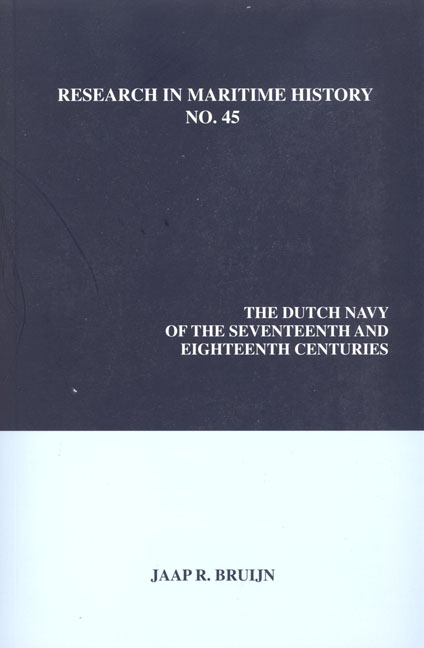Book contents
- Frontmatter
- Contents
- Illustrations
- Tables
- Series Editor's Foreword
- About the Author
- Introduction to the 2011 Edition
- Foreword
- Preface
- Introduction
- Map of the Dutch Republic
- Map of Dutch Naval Activity in European Waters
- Part One The “Old” Navy, Late 1500s-1652
- Naval Operations against Spain and the Dunkirk Privateers
- The Boards of the Admiralties at Work
- The Slow Birth of a Naval Officers' Corps
- Truly International Crews
- Part Two The “New” Navy, 1652-1713
- Part Three A Second-Rate Navy, 1714-1795
- In Retrospect
- Bibliography
- Index
Naval Operations against Spain and the Dunkirk Privateers
from Part One - The “Old” Navy, Late 1500s-1652
- Frontmatter
- Contents
- Illustrations
- Tables
- Series Editor's Foreword
- About the Author
- Introduction to the 2011 Edition
- Foreword
- Preface
- Introduction
- Map of the Dutch Republic
- Map of Dutch Naval Activity in European Waters
- Part One The “Old” Navy, Late 1500s-1652
- Naval Operations against Spain and the Dunkirk Privateers
- The Boards of the Admiralties at Work
- The Slow Birth of a Naval Officers' Corps
- Truly International Crews
- Part Two The “New” Navy, 1652-1713
- Part Three A Second-Rate Navy, 1714-1795
- In Retrospect
- Bibliography
- Index
Summary
Naval operations were initially concentrated in the Zuyderzee and on the estuaries and inlets of Zeeland. The campaigns of Prince Maurice had to be supported. The scope was widened when warships began to accompany the merchantmen, whereupon Dutch fleets appeared off the Iberian coast and even as far afield as the Mediterranean. This resulted in the Dutch increasingly stealing the initiative at sea from their Iberian opponents, for the States General felt strong enough to bring the war to the doorstep of Spain and Portugal and even to Spain's and Portugal's overseas territories.
The economic battle required a permanent blockade of the Flemish coast and the Scheldt River of the Spanish Netherlands. A great number of ships maintained this difficult and often boring vigil. The blockade was intensified whenever the enemy launched its most dangerous weapon, Flemish privateers in raids on Dutch merchant shipping. Although these raids never became a decisive factor, they did cause sufficient damage to force the Dutch naval authorities to commit a major part of their forces to combat them. Strengthening the blockade and providing more escorts for convoys left only a few forces available for mounting expeditions against the Iberian Peninsula. The fight against the Spaniards and the Portuguese beyond European waters was entrusted mainly to the East India Company (known in the Republic as the VOC) after its creation in 1602 and to the West India Company (WIC), which was founded in 1621, the year the Twelve Years’ Truce ended. The admiralties only occasionally participated in this global struggle.
Other naval activities resulted from the growth of merchant shipping in the Mediterranean and the Baltic Sea and from the increased political stature of the Republic. Shipping in the Mediterranean confronted the Barbary corsairs, who were countered by offensive raids as well as defensive convoys. In the Baltic, Dutch economic interests occasionally required a naval presence, often near the Danish Sound. Naval pressure was also used as a tool of diplomacy whenever a Dutch maritime presence existed.
Late 1500S-1609
Following the defeat of the Spanish Armada in 1588, the Dutch admiralties undertook four different operations: 1) patrolling the rivers, inlets, estuaries and the Zuyderzee; 2) cruising off the Flemish coast; 3) cruising in the North Sea and the Channel; and 4) sailing on convoy duties. Beginning in 1589, they developed an annual plan for these operations, with certain numbers of ships being allocated.
- Type
- Chapter
- Information
- Publisher: Liverpool University PressPrint publication year: 2011



